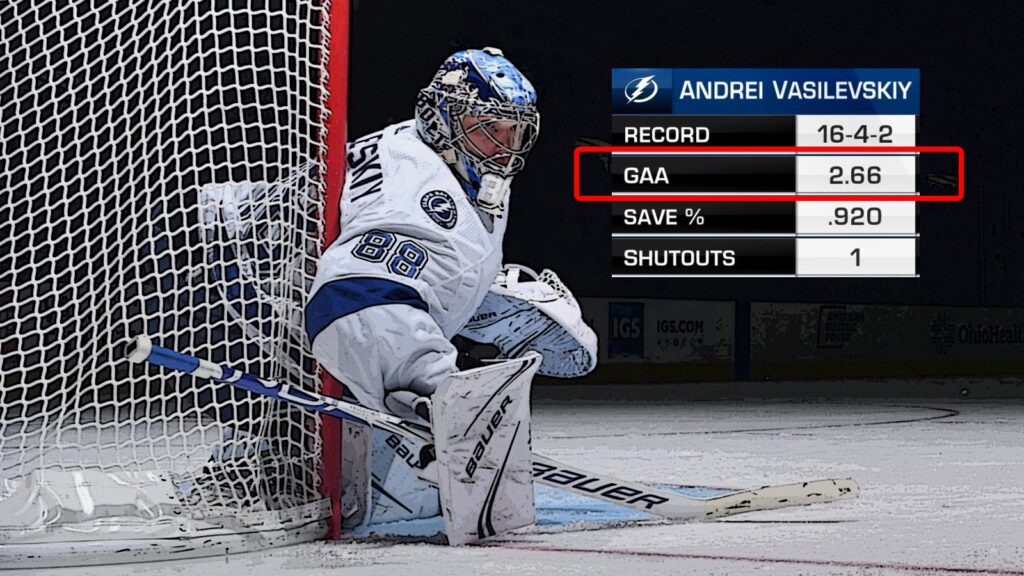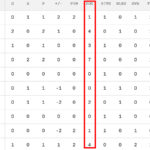Ever wonder what those goaltender statistics are during a hockey pregame report?
They usually reference on four stats in particular: Win Record, GAA, SV% and Shutouts.
The win record is self-explanatory, which is how the goalie’s win-loss totals during the season.
The SV% or save percentage proportion of saves they’ve made relative to the total shots faced.
Shutouts is the number of times the goalie was able to blank out the opposing team from scoring in a game.
That leaves us with the GAA…
What is GAA in Hockey?
GAA is the acronym for goals against average for goaltenders in hockey. Goals against average is the number of goals allowed per 60 minutes of play over the course of the season. GAA is an essential stat used to evaluate the success or struggles of each goalie.
As mentioned earlier, GAA appears with the Save Percentage, Win Record and Shutouts in every pregame matchup.

The value displayed for GAA is rounded to two decimal places such as 2.25.
However, the calculation required can seem somewhat intriguing to the average fan.
At first thought, if a goalie let’s in three goals in a game, the general assumption is that their goals against ended up being 3.00.
While this can be true, it's just as possible not to be. And it happens more often than you think.
So, what do I mean by this?
When determining GAA, the NHL (and other pro leagues) suggests that one game equals to 60 minutes of play.
The 60 minutes is the equivalent to your standard 3x twenty-minute periods, known as regulation time in a game.
But goalies might not always play the expected 60-minutes time frame. It's possible they play more or less than that.
For example, the game can go to overtime, where the additional game time is increased by as much as five minutes.
Meanwhile, there are times when the goalie gets pulled towards the end of regulation, such as when his team is trailing on the scoreboard.
The goalie is removed in favor of an extra attacker with the hope of evening up the score.
Those seconds or minutes the goalie is on the bench is deducted from their overall playing time.
As a result, the goalie never actually plays the exact 60 minutes.
Keep in mind that the GAA value is based on an average per game, or precisely sixty minutes of play.
That said, let me explain how we calculate GAA.
How to calculate GAA
The two necessary elements to calculate GAA are goals allowed and total minutes played.
Goals allowed only relate to goals the netminder was present for on the ice.
Any goal that is scored when they are removed from the net, even if temporary, will not count against their GAA.
So, let’s get to the formula:
GAA = Goals Allowed / (Minutes Played / 60 Minutes per Game)
GAA = 3 / (65min / 60min) = 2.77 (rounded to 2nd decimal place)
Note: 65 minutes played means 60 minutes of regulation plus the full 5 minutes of overtime.
You can apply this formula for an individual game, or over the course of the season.
Furthermore, goals scored in the shootouts do not count against the GAA.
Goals Against Average Calculator
What is a good GAA?
A good goals against average is relative to the cumulative stats of all goalies combined.
Back in the 1980’s, your top goaltenders were allowing more than 3 goals per game.
In today’s game, that average falls between 2-3 goals against.
Anything under 2.00 is extraordinary, while slightly above (i.e. 2.09) is still quite impressive.
I wrote a blog post with explaining what I thought was a good GAA.
When I scan the goalie stats for the 2022-23 NHL season to date, only Linus Ullmark has a GAA in the sub-twos (1.88 exactly).
If you filter out the goalies who’ve played at least a third of the season, 34 (of 55) goalies have less than a 3.00 GAA.
My assessment still holds true til today:
| Goals Against Average (GAA) | Description |
|---|---|
| <2.00 | Excellent |
| 2.00-2.40 | Very Good |
| 2.41-2.70 | Good |
| 2.71-3.00 | Fair |
| >3.00 | Bad |
The goals against average doesn’t tell the whole story because the team may be allowing high shot totals on net.
So, while a goalie’s GAA is at 2.90, their save percentage could be a respectable 0.910 or better.
I explain this in my blog post What is the Average Save Percentage in the NHL?
Final Thoughts
Heading into the playoffs, a great (or even good) GAA will carry your team a long way.
But a solid goals against average doesn’t make up for a lethargic offense.
You rarely witness stellar goaltending making up for the team’s shortcomings in scoring.
Those days are long gone where Martin Brodeur and Dominik Hasek (both goalies) were the main characters in chasing the Stanley Cup.
In today’s game, you need more than one scoring line and a shutdown goalie.
You need the effort from lines 2 and 3 along with contribution from the defense (i.e Cale Makar of the Colorado Avalanche).
When the scoring wheels are well greased, the bonus of solid goaltending will help seal the deal.






